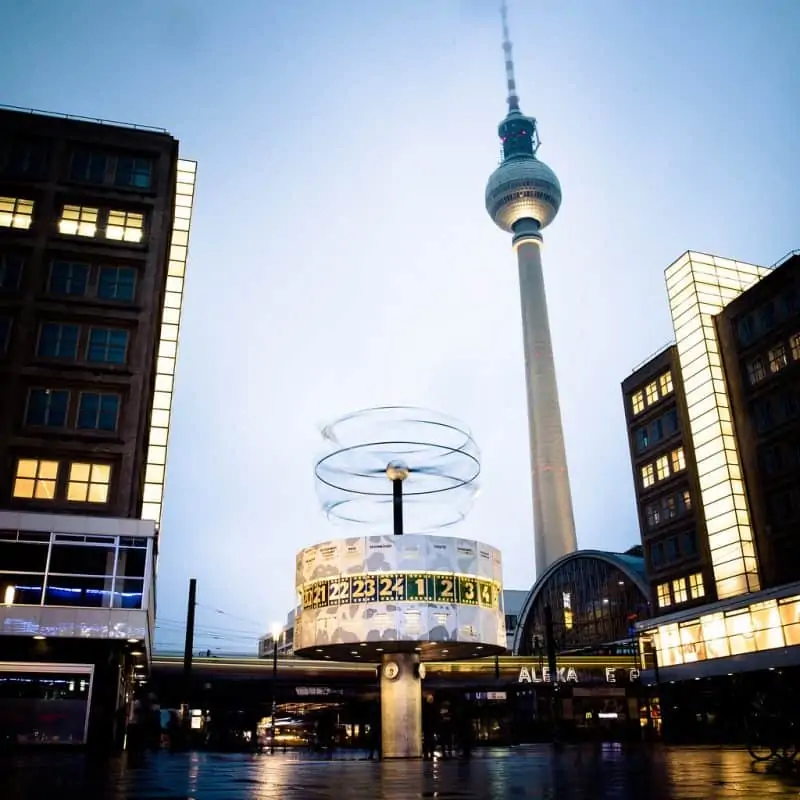With over 40 UNESCO-recognized World Heritage Sites, including artistic architectural masterpieces, historical and cultural landmarks, and stunning natural landscapes, Germany is an unmissable destination in Europe for those who love travel and exploration. Traveling to Germany also captivates visitors with its countless fascinating aspects, from a vibrant culture and rich cuisine to unique customs and traditions. Let’s dive into the essential information you need to know about traveling to Germany in the article below!
Introduction to Germany
Official Name: Federal Republic of Germany – English: Germany
Currency: Euro
Official Language: German
Capital: Berlin
Population: Approximately 82 million (2018)
Located at the heart of Europe, Germany is the continent’s largest country both in terms of population and economic scale. It’s a nation that blends long-standing cultural traditions with a modern, dynamic society thriving in science and technology.
Berlin, the capital, is a modern and vibrant city. Germany feels like a microcosm of Europe, boasting Icelandic-style geysers, gondolas straight from Venice, and many other wonders. With its historic cities, charming small towns, world-famous landmarks, and breathtaking mountain scenery, travelers have endless options when visiting Germany. Art and scenery enthusiasts can explore urban hubs like Munich, Frankfurt, or Hamburg. For those seeking nature adventures, the Bavarian Alps, Black Forest, or Rhine Valley are must-visits. Beyond that, Germany is dotted with ancient churches, grand palaces, and medieval towns hosting traditional Christmas markets, festivals, and fairs that draw crowds year-round.
Travel Tips for Germany
Applying for a German Tourist Visa
As a member of the Schengen Area, Germany allows citizens of 62 countries to enter for tourism without a visa. Unfortunately, Vietnamese citizens are not on this list, so a visa is required.
Here’s a list of documents you’ll need to apply for a German tourist visa:
- A fully completed and signed visa application form.
- Two recent passport-sized photos (45mm x 35mm).
- A valid passport (issued within the last 10 years) with at least two blank pages.
- Personal documents: Household registration book; ID card. If married, include a marriage certificate, spouse’s ID, and children’s birth certificates.
- Proof of employment:
- For employees: Employment contract stating position and duration, payslips, approved leave request, and social insurance book.
- For business owners: Business registration certificate and tax reports for the last three months.
- For retirees: Pension statements for the last three months and pension card.
- For students: School confirmation letter and student ID.
- Financial proof: Bank statements and documents of assets (e.g., property deeds, car ownership, stocks).
- Detailed travel itinerary: Travel schedule, hotel booking confirmation, round-trip flight reservation, and travel health insurance.
All documents must be translated into English or German and submitted with one original and one photocopy (notarization not required). After preparing your documents, book an appointment online at the Visa Application Center (VFS). You’ll receive a confirmation email—print it out and bring it to your appointment to submit your application and pay the fee, currently 80 euros (approximately 2,100,000 VND). You’ll also need to provide fingerprints and a photo at the center. Processing typically takes about 15 days but may take longer if additional documents or an interview are requested.
Flights and Airlines to Germany
Several airlines operate flights from Vietnam to Germany, including Vietnam Airlines, Thai Airways, Qatar Airways, Turkish Airlines, Air France, Singapore Airlines, and Malaysia Airlines. Each offers varying schedules and times, giving travelers plenty of choices. However, there are no direct flights yet—most routes involve one or two stopovers in cities like Bangkok, Kuala Lumpur, Doha, Istanbul, or Paris, depending on the airline.
Germany has seven international airports, including Düsseldorf, Frankfurt, Berlin Brandenburg, Munster Osnabruck, Munich, and Hannover. Flights from Vietnam, departing from Hanoi, Ho Chi Minh City, or Da Nang, typically land at Frankfurt, Berlin Brandenburg, or Munich. With stopovers, flight times range from 13 to 19 hours. Here are some options:
- Thai Airways: Flights to Munich or Frankfurt, 13–15 hours, stopover in Bangkok. Tickets cost around 8–10 million VND per leg.
- Malaysia Airlines: Stopovers in Kuala Lumpur and Doha, about 19 hours, round-trip around 19 million VND.
- Qatar Airways: 15-hour flight with a stopover in Doha, round-trip around 20 million VND.
- Emirates: Flights to Munich, about 20 hours, starting at 25 million VND.
- Singapore Airlines: 16-hour flight with a stopover in Singapore, around 22 million VND.
Choose an airline and destination based on your travel plans in Germany.
What Makes Germany Famous for Tourism
Top Tourist Destinations in Germany
Where should you go in Germany? It’s a tough question for many, given the country’s wealth of attractions—nearly 50 UNESCO World Heritage Sites, striking architecture, and awe-inspiring landscapes. Here are some standout destinations to consider:
Black Forest
The Schwarzwald, or Black Forest, in southwest Germany gets its name from its dense trees and sprawling woodlands. It’s a paradise for nature lovers and outdoor enthusiasts.
Rhine Valley
The Rhine Valley, the most famous stretch of the Rhine River, runs from Koblenz to Bingen. Flanked by steep, vineyard-covered hills and dotted with ancient castles and ruins, it offers a timeless, breathtaking view.
Frauenkirche, Germany
Located in Dresden, Frauenkirche (Church of Our Lady) is a Lutheran church rebuilt to its original 1720s design and reopened in 2005. The golden cross atop its dome was a gift from Coventry, a city bombed by the German air force during WWII. Since reopening, it’s become a top tourist draw in Dresden.
Lindau, Germany
The historic town of Lindau sits near the meeting point of the Austrian, German, and Swiss borders on the eastern shore of Lake Constance. Connected to the mainland by a bridge and railway, this small town of about 3,000 residents charms visitors with its medieval and half-timbered buildings.
Cologne Cathedral
Germany’s grandest Gothic cathedral, Cologne Cathedral (Kölner Dom), has been a defining landmark for centuries. Construction began in 1248 and took over 600 years to complete. Dedicated to Saints Peter and Mary, it now serves as the seat of Cologne’s Catholic Archbishop.
Holstentor
Holstentor, one of Lübeck’s two remaining city gates, was built in 1464 and now functions as a museum. With its twin round towers and arched entrance, it’s a beloved symbol of the city.
Old Town of Heidelberg
Nestled in the Neckar River valley, Heidelberg is one of Germany’s most popular destinations. Its narrow baroque streets, picturesque houses, and famous Heidelberg Castle exude timeless charm.
Brandenburg Gate
The sole surviving city gate of Berlin, the Brandenburg Gate symbolizes the reunification of East and West Berlin. Built in the 18th century, it marks the start of Unter den Linden, a grand boulevard lined with linden trees that once led to the Prussian kings’ palace.
Neuschwanstein Castle, Germany
A true fairy-tale castle, Neuschwanstein perches on a rugged hill near Füssen in southwest Bavaria. It’s the most photographed building in Germany and one of the country’s top tourist attractions.
Famous German Dishes
German cuisine reflects the country’s agricultural roots and the influence of immigrants who’ve settled here over centuries.
Königsberger Klopse
These flavorful meatballs in a creamy white caper sauce are a favorite among home cooks and chefs alike. Traditionally made with minced veal, onions, eggs, anchovies, pepper, and spices, they’re a comforting classic.
Maultaschen
Especially popular in southern Germany, Maultaschen are square dough pockets about the size of your palm. Fillings range from savory to sweet, meaty to vegetarian.
Labskaus
A northern German delight, Labskaus blends corned beef, onions, potatoes, and pickled beets into a porridge-like dish, served with pickled gherkins and rollmops.
Sausages
Germany’s best street food, bratwurst—or fried sausages—comes in over 40 varieties. Grilled or pan-fried, they’re served in a white roll with mustard on the go, or paired with potato salad or sauerkraut alongside a German beer.
Doner Kebab
Brought to Germany by Turkish immigrants in the 1960s and ‘70s, the doner kebab started as a simple mix of meat, onions, and a bit of salad in bread. It’s since evolved into a customizable dish with various salads, veggies, and sauces.
Schnitzel
This breaded, fried cutlet is a staple across Germany. Locals love topping it with a variety of sauces.
Rouladen
Rouladen combines bacon, onions, mustard, and pickles wrapped in thinly sliced beef or veal. It’s a hearty main dish for family dinners and special occasions.
Sauerbraten
Considered one of Germany’s national dishes, Sauerbraten is marinated for days in red wine vinegar, herbs, and spices before cooking. It’s traditionally served with red cabbage, potato dumplings, or boiled potatoes.
What to Prepare for a Trip to Germany
Preparation is key for a smooth, worry-free trip to Germany, especially if you’re traveling independently.
Plan Your Itinerary, Book Flights, and Reserve Accommodation: Start by deciding how many days you’ll spend in Germany and which places you’ll visit. This helps you book flights and lodging that fit your schedule. Booking early can snag you cheaper airfare, and you’ll need flight and hotel confirmations for your visa application.
Prepare Documentation: As mentioned earlier, Vietnamese citizens need a visa to enter Germany. To ensure it’s issued in time, gather all required documents (listed above) and submit them to the consulate at least one to two months before your trip.
Pack Accordingly: Your clothing depends on when you’re visiting. Winter months are chilly, so bring thick, warm layers. Summer calls for light, comfortable outfits suited for exploring. Pack basic medications like cold remedies, stomach aids, or motion sickness pills too.
Currency: Germany uses the euro. Exchange some cash for convenience in shopping and dining, but don’t carry too much to avoid loss or theft—keep most in your bank card. You can withdraw cash at public spots like train stations or airports, and credit cards are widely accepted in big cities.
Important Notes When Traveling to Germany
The best time to visit Germany is summer, from June to August, when the weather is cool and pleasant—perfect for sightseeing.
By law, shops in Germany close on Sundays. If you plan to shop for yourself or gifts, schedule it for other days.
As a top European destination, Germany’s hotels can fill up fast. Book your stay one to two months in advance to secure a spot.
Frequently Asked Questions
How Long Is a German Tourist Visa Valid?
The visa’s validity depends on the dates specified, the maximum stay allowed, and the number of entries. Typically, a German tourist visa is valid for 180 days, with a maximum stay of 90 days.
What Should You Buy in Germany?
Germany is a haven for fashion and cosmetics, with countless renowned, high-quality brands. Check out shopping hubs in Berlin like KaDeWe or the Kurfürstendamm fashion boulevard. Handcrafted wooden items and chocolate also make fantastic souvenirs.











